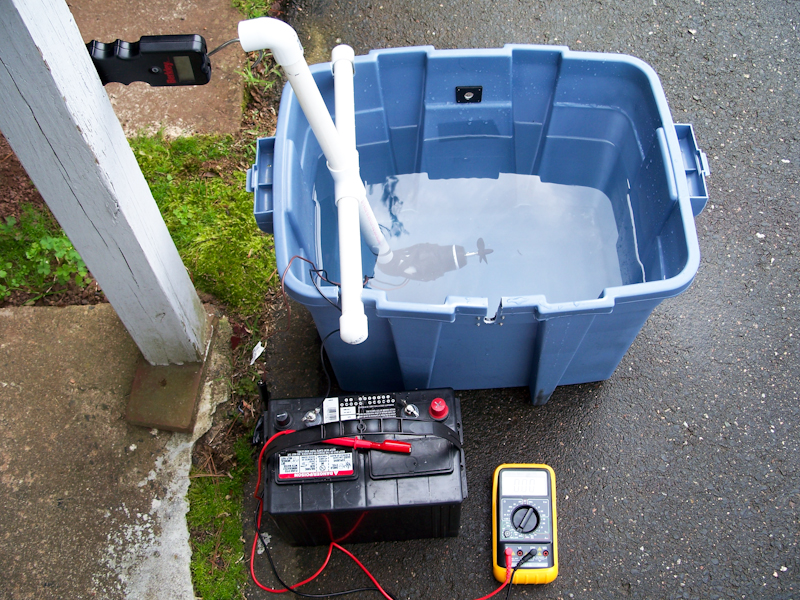|
How To's
Tether - Power and Voltage Drop Examples |
|
|
|
Selecting the right GAUGE wire to power your Rov through the tether can make or break your Rov. (so to speak)
Gauge or AWG (American Wire Gauge) is the standard system (in the USA) of determining the diameter of the conductor of wire. The first thing I should point out is when it comes to Gauge size is the lower the number the thicker the conductor is. (so 14 Gauge is thicker than 20 Gauge.) Selecting too thin of a wire gauge will result in a huge power loss at the thruster because of the voltage drop. Voltage Drop is just what it sounds like, it is the loss of voltage between the power source (battery) and the load (thrusters) To put it in layman's terms...the more power (amps) your thrusters use (draw) the greater the voltage loss will be which means less thrust your thrusters will make. To complicate things even more.....the longer your tether is, the more voltage drop you will have also. Because of many factors such as the draw of your particular thrusters, length of tether, ect. I can't tell you exactly what size Gauge wire to use on your Rov but there are a lot of voltage drop calculators on the web you can use to figure what would be best for you. Formulas are good and all but I have done a few actual tests on a few common gauges that should serve as actual examples of what to expect, below are those results. |
|
|
 |
|
My tests where done using a Mayfiar 750 GPH Bilge Pump Thruster running a Robbe 3 blade 50mm 42 Pitch Prop. I measured Thrust, Amps, and Voltage at the Thruster using a few different gauge wires each 100' in length.
|
|
|
 |
| Power was supplied by a 12 volt marine battery (the same battery I use for most of my Rov's.) The battery was putting out about 13.5 volts. (as seen above) |
 |
| The 3 common size wires I used were 14, 16, and 20 Gauge. (I would have like to use 18 instead of the 20 gauge but I didn't have a 100' piece) The 24 gauge wire is actually cat5 computer cable and I only tested this to show how bad it is to try and send power over. Using cat5 is ok for controlling relays but don't waste your time trying to power thrusters with it. |
|
|
|
|
| The table above shows the results of my tests. I'll let you draw your own conclusions from them, but my advice would be not to run anything less than 16 gauge wire at 100'. I have run 18 gauge wire (not shown) with ok results on my Seafox but this was only with a 50' tether.
The bottom section of the table shows just how worthless cat5 cable is for powering thrusters. Using one pair of wires only allowed the thruster around 3.6 volts and produced less than a twentieth of the thrust the pump is capable of when directly hooked to the battery, even doubling up the pairs (4 wires) only produced a dismal half pound of thrust. Keep in mind all these tests where only done with one thruster running, if you are using a common power feed to all thrusters (say through a relay setup) and are using 2 thrusters at once to go forward the voltage drop will be increased and the power output will be less per thruster. Running 2 thrusters at once will still be more thrust so it's a balance of draw vs thrust. A few other things to consider when selecting wire are weight and flexibility. The thicker the wire is the heavy and stiffer it will be, so there is always trade off's. |
|
|
 |
| I did some more tests today, the table above shows the results of running 2 thrusters at once. Like I stated above, you can see there is a loss of thrust per thruster because of the added voltage drop of running 2 pumps at once but you do increase overall thrust using 2 thrusters.
For example - over 100' of 16 Gauge wire one thruster would put out 1.5 Lbs. of thrust at 4.50 amps, but running 2 thrusters each pump will only put out 1.1 Lbs. but for a total of 2.2 Lbs of forward thrust at 7 amps. |
|
If you have any other questions I didn't cover feel free to E-mail me.
|
| All Information, Pictures, and Material is copyright © 1998-2009 by Stephen Thone and may not be used for any personal or commercial purposes without the consent of the author. All rights reserved. The Author makes no guarantees or warranties as to the accuracy or completeness of, or results to be obtained from accessing and using the Information herein. | |||
